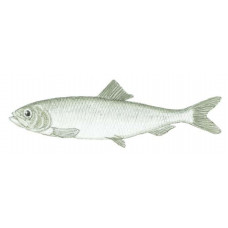Latin name
Clupea pallasii
Other names
Herring, north Pacific herring; French: hareng Pacifique; Japanese: nishin; Spanish: arenque del Pacifico.
Identification
The body is prostrate, compressed from the sides, covered with easily drooping scales. Abdomen rounded, ventral keeled scales more or less developed only behind base of pelvic fins. Head 19.0-20.8% of body length. Mouth medium-sized, the end of the upper jaw reaches the vertical of the middle of the eye. Teeth weak. Cap bone, without furrows. Dorsum dark blue, flanks light without spots, abdomen silvery-white.
Distribution
Pacific herring form isolated herds. Several local herds are found along the American coast. In the western Pacific, Pacific herring occur from Anadyr Bay and the eastern coast of Kamchatka, including possibly the Aleutian Islands, south to Japan and the western coast of Korea. In the eastern Pacific, they occur from the Kent Peninsula and Beaufort Sea south to northern Baja California.
Habitat
Sea fish. But it does not avoid significantly desalinated waters, sometimes entering river estuaries with the tide and even rising into some lakes. A gregarious fish, a typical representative of the boreal complex. When waters warm up in summer, it moves away from shores and goes to relatively large depths. Pacific herring lives in coastal waters, and in the summer of the first year of life, young fish appear on the surface in schools. In the fall, the schools disappear as the young move into deeper waters, to a depth of 1,558 feet, and remain there for the next 2-3 years.
Size
Length up to 50 cm, weight over 725 g. Southern Primorye herring has the highest growth rate. By the age of three years, the length of an individual reaches 28-29 cm. The time of sexual maturity varies considerably: Primorye herring matures first at 3-4 years of age, Southern Sakhalin and Okhotsk herring at 4-5 years of age. In British Columbia, herring is distinguished by early maturity (3 years). Life expectancy is the longest in Central Alaska herring - 16-17 years and 14-15 years in Eastern Kamchatka. In the Sea of Okhotsk, herring older than 10-11 years are rare. British Columbia herring has the shortest life cycle - 6-7 years. Pacific herring can grow up to 18 inches long.
Life history and Behavior
Pacific herrings do not migrate as long as Atlantic and Scandinavian herrings. But almost all herds of Pacific herring fatten and winter in the open sea, sometimes 150-200 miles offshore. Depending on latitude, adults migrate to coastal areas from December through July, entering estuaries to breed. These herrings do not show strong north-south migrations, and their populations are localized. Like other herrings, they gather in large numbers.
Food and feeding habits
Pacific herring larvae feed on planktonic food, including ostracods, small copepods, small fish larvae, euphausiids, and diatom algae. Juveniles feed on crustaceans as well as small fish, marine worms, and larval mollusks. Adults feed on larger crustaceans and small fish.
Reproduction
Spawning takes place within the entire range. Salinity at different spawning grounds can be from 12 to 32-33%. Eggs develop in 23-24 days at 3°С and in 16-17 days at 6°С.
| Classification | |
| Phylum | Chordata |
| Class | Actinopterygii |
| Squad | Perciformes |
| Family | Serranidae |
| Genus | Epinephelus guttatus |
| Species | E. guttatus |
| Features | |
| Conservation status | Least Concern |
| Habitat | Littoral |
| Life span, years | 22 |
| Maximum body weight, kg | 22 |
| Maximum length, cm | 76 |
| Sailing speed, m/s | No information |
| Threat to people | Edible |
| Way of eating | Predator |




